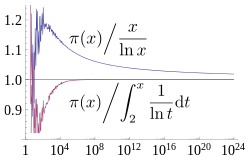Slika:Prime number theorem ratio convergence.svg

Velikost tega predogleda PNG datoteke SVG: 250 × 160 točk. Druge ločljivosti: 320 × 205 točk | 640 × 410 točk | 1.024 × 655 točk | 1.280 × 819 točk | 2.560 × 1.638 točk.
Izvorna datoteka (Datoteka SVG, nominalno 250 × 160 pikslov, velikost datoteke: 87 KB)
Zgodovina datoteke
Kliknite datum in čas za ogled datoteke, ki je bila takrat naložena.
| Datum in čas | Sličica | Velikost | Uporabnik | Komentar | |
|---|---|---|---|---|---|
| trenutno | 15:07, 21. marec 2013 |  | 250 × 160 (87 KB) | Dcoetzee | Change n to x to match article |
| 14:30, 21. marec 2013 |  | 250 × 160 (86 KB) | Dcoetzee | Convert formula from graphics to pure SVG using http://www.tlhiv.org/ltxpreview/ | |
| 14:23, 21. marec 2013 |  | 250 × 160 (130 KB) | Dcoetzee | {{Information |Description ={{en|1=A plot showing how two estimates described by the prime number theorem, <math>\frac{n}{\ln n}</math> and <math>\int_2^n \frac{1}{\ln t} \mathrm{d}t = Li(n) = li(n) - li(2)</math> converge asymptotically towards <ma... |
Uporaba datoteke
Datoteka je del naslednje 1 strani slovenske Wikipedije (strani drugih projektov niso navedene):
Globalna uporaba datoteke
To datoteko uporabljajo tudi naslednji vikiji:
- Uporaba na ar.wikipedia.org
- Uporaba na bn.wikipedia.org
- Uporaba na ca.wikipedia.org
- Uporaba na el.wikipedia.org
- Uporaba na en.wikipedia.org
- Uporaba na fa.wikipedia.org
- Uporaba na he.wikipedia.org
- Uporaba na hu.wikipedia.org
- Uporaba na hy.wikipedia.org
- Uporaba na id.wikipedia.org
- Uporaba na ja.wikipedia.org
- Uporaba na no.wikipedia.org
- Uporaba na pl.wikipedia.org
- Uporaba na sr.wikipedia.org
- Uporaba na sv.wikipedia.org
- Uporaba na ta.wikipedia.org
- Uporaba na vi.wikipedia.org





